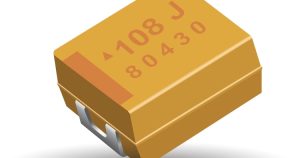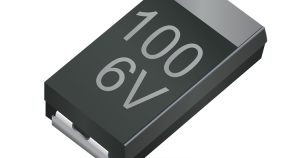Reverse Voltage Behavior of Solid Tantalum Capacitors Written By: Ian Bishop | John Gill Abstract: This paper is intended to give the design engineer an understanding of the effects of reverse voltage operation on the chemical structure and life reliability of a tantalum capacitor. It also aims to show a circuit design engineer about predicting the life performance of a circuit where a tantalum capacitor is subjected to negative voltages.
Tantalum / Niobium / Polymer
Reliability Management of Tantalum Capacitors Written By: Chris Reynolds Abstract: Tantalum capacitors can achieve high reliability in steady state applications. Tantalum capacitors have highly stable capacitance and frequency dependent characteristics. Short circuits are a low level, but not negligible, failure mode. Because of this, reliability management of tantalum chips means the effective control of the S/C failure mode, not least because this mode cannot be designed around by use of redundancy circuits, etc.
Reaching the Highest Reliability for Tantalum Capacitors Written By: James Bates | Marc Beaulieu | Michael Miller | Joseph Paulus Abstract: Weibull reliability assessment has been used for characterization of tantalum capacitors for many decades driven by MIL standards. Over time major improvements have been made in process, material, testing, equipment and other process control. Is Weibull still the best fit for today’s technology and Hi-Rel applications? A new approach is needed since the current Weibull grading to assure reliability has deficiencies, in particular, the need for early life failures and the potentially damaging application of excessive voltage during the burn-in in an effort to maximize the Weibull acceleration factor. This paper will discuss modifications to the existing burn-in process,
Next Generation of High Voltage, Low ESR SMD Tantalum Conductive Polymer Capacitors Exceeds 100V Milestone Written By: T. Zedníček | M.Bárta | J.Petržílek | M.Uher | I.Horáček | J. Tomáško | L. Djebara Abstract: Tantalum capacitors designed for high voltage applications (above 25V) have been used for many years in telecommunication, industrial, automotive or other high reliability applications. The conventional high voltage tantalum capacitor design is using a manganese dioxide cathode that provides good reliability, stability and robustness. Nevertheless there are certain limitations. First of all it is the operating voltage – even with optimized processes of dielectric formation, rated voltages of such parts are mostly limited to 50 or 63V. The other limitation is ESR. Very low ESR values
New Tantalum Technologies Tantalum Polymer and Niobium Oxide Capacitors Written By: T.Zedníček Abstract: Tantalum has been a favored capacitor technology in space-limited designs and high reliability applications for a long time. Recent years have seen the emergence of one or two equivalent technologies offering many of the advantages of tantalum, such as volumetric efficiency and reliability. Two new technologies recently introduced into their commercialization phase are niobium oxide capacitors and tantalum capacitors with conductive polymer cathodes. A circuit designer trying to choose between these solid electrolyte capacitor systems has a number of trade-offs and subtleties of operation to consider. This paper reviews the main features of the two technologies, the latest electronic application needs and discusses the feasibility of the
Investigation Into the Effects of Connecting Tantalum Capacitors in Series Written By: J.A. Gill Abstract: This paper demonstrates how high voltage capacitors can be made by connecting lower voltage rated parts in series. How to create large banks of capacitance by parallel and series combinations of capacitors without sacrificing reliability is also discussed.
Improved ESR on MnO2 Tantalum Capacitors at Wide Voltage Range Written By: I. Horacek | T. Zednicek | M. Komarek | J. Tomasko | S. Zednicek | W. A. Millman | J. Sikula | J. Hlavka Abstract: One common trend in switch-mode power supply, micro-processor, and digital circuit applications is to achieve reduced noise while operating at higher frequencies. In order to realize this, components with low Equivalent Series Resistance (ESR), high capacitance and high reliability are required. A new generation of Low ESR tantalum chip capacitors has been developed utilizing a low resistivity MnO2 electrolyte that enables very low component ESR. MnO2 technology provides excellent field performance, environmental stability and high electrical and thermal stress resistance in wide voltage
High CV Wet Tantalum DC Capacitors Written By: T.Zedníček | J.Petržílek Abstract: There are very many DC back up applications that require high energy storage capability. Rechargeable batteries and double layer carbon capacitors, (Electric Double Layer Capacitors or EDLC), have certain limitations in high temperature and harsh operational conditions. This paper will describe a novel application and design concept approach that will introduce High CV wet tantalum capacitors into this arena. Comparisons with supercapacitors and conventional wet tantalum capacitors will be given, with benchmarking of the capacitor technologies.
High CV Tantalum Capacitors Challenges and Limitations Written By: I.Horacek | T.Zednicek | S.Zednicek | T.Karnik | J.Petrzilek | P.Jacisko | P.Gregorova | I. Pinwill Abstract: The trend toward portable electronics is a major driving force in the need for miniaturisation of electronic components. Tantalum capacitors are becoming a product of first choice where high electrical and mechanical stability along with long service life and volumetric efficiency are demanded. The latest generation of ultra-high surface area tantalum powders in combination with an efficient constructional and encapsulation system provides a new solution for the next generation of component downsizing. This paper describes the main challenges and limitations in processes and materials that have been necessary to overcome for increased capacitance and
Hermetically Sealed 230°C MnO2 Tantalum Capacitors Written By: T. Zednicek | M. Biler | J. Petrzilek | I. Pinwill Abstract: Certain electronic applications, such as oil and gas exploration drilling, are continuously demanding ever higher operating temperatures. Recently operating temperature requirements have increased from 200°C to 230°C with an increased operating life from hours to one thousand hours and beyond. This need is linked with the continuous development of oil drilling heads and sensors and their use for deeper drilling or drilling in more difficult geological conditions. Capacitors with high capacitance value are a common part of the electronic boards used in these applications, but over 125°C/175°C, available capacitor choice is very limited. Tantalum SMD capacitor technology has proved its
Glossary Of Terms Used in the Tantalum Industry Written By: John Gill Abstract: Terms used in the tantalum industry can often be confusing to the layperson. The purpose of this paper is to allow someone to look up any terms of which he or she is unsure. It is directed at the reader of technical literature in particular.
Equivalent Series Resistance of Tantalum Capacitors Written By: R.W. Franklin Abstract: The resistive losses which occur with all practical forms of capacitor are made up from several different mechanisms, including resistance in components and contacts, viscous forces within the dielectric and defects producing bypassing current paths. To express the effect of these various factors on the behavior of an electrolytic capacitor they are lumped together as one term, the equivalent series resistance (ESR).
Temperature Stability Assessment of GaN Power Amplifiers with Matching Tantalum Capacitors Written By: T.Zednicek | R.Demcko | M.Weaver | D.West | T. Blecha | F.Steiner | J.Svarny | R.Linhart Abstract: Wide band gap GaN and SiC devices are expected to experience high levels of growth in applications ranging from power conversion to RF transistors and MMICs. End users recognize the advantages of GaN technology as an ability to operate under higher currents and voltages. RF GaN market is expected to grow at 22.9 % CAGR over 2017-2023, boosted by implementation of 5G networks. [1] During the past years, the wide band semiconductors have reported achievement of >1000 V BDV that opens new challenges for high power industrial applications such as
Solid Tantalum Capacitors: MnO2 vs. Polymer Cathodes for Optimal Performance in High-Reliability Military and Space Applications Written By: Ron Demcko Abstract: Solid tantalum capacitors have a long history of proven performance in high-reliability military and space applications. But not all capacitors are created equal — even within the same class. As is the case with virtually all component technologies, materials matter. This paper will discuss the differences in performance and reliability between solid tantalum capacitors with manganese dioxide (MnO2) cathodes and those with conductive polymer cathodes. Bell Laboratories introduced the first solid tantalum capacitors to market in the early 1950s. The first military specification for surface-mount tantalum capacitors (MIL-PRF-55365) was released in 1989 and introduced CWR09-style components. Since then, the
High-Reliability Solid Tantalum Capacitors Written By: Bob Fairey Abstract: Solid tantalum capacitors are among the most popular types of small, surface-mount capacitors for electronic applications across the consumer, automotive, aerospace, and medical device markets. This paper will provide some context on the development of tantalum capacitor technology and address issues frequently faced by users, including the need for low equivalent series resistance (ESR) in filtering applications and the need for the highest possible reliability and long-lifetime performance in aerospace and medical applications.
Equivalent Circuit Model for Tantalum and Niobium Oxide Capacitors for use in Simulation Software Written By: J. Pelcak Abstract: In electrical circuit simulations with simulation software, ideal passive components (resistors, capacitors, inductors) are typically used because real component characteristics have been difficult to model. Unfortunately, ideal and real passive components have significant differences in their electrical behavior. These differences lead to discrepancies between actual hardware performance and expected results based upon simulation software programs. This paper will describe the development of equivalent circuit diagram for modeling real capacitor behavior. Use of this real model in simulation software can help make circuit development more efficient, as the circuits in the simulations should have similar behavior to the actual circuits. The model











